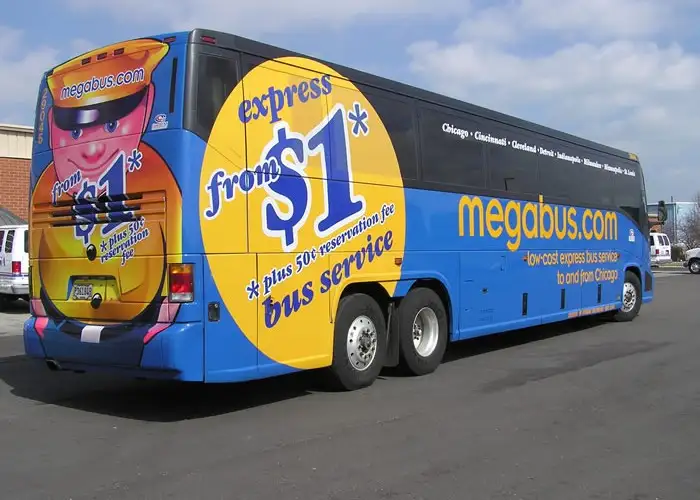
Riding the bus is no longer the last travel resort for students and budget travelers. Several big bus operators are competing for a share of the mainstream travel market with improved buses and faster schedules.
The bus “renaissance” in the United States was kicked off in 2006 by Megabus, a unit of Coach USA and a subsidiary of the Stagecoach Group, a big British rail-and-bus operator. It follows principles evolved in the United Kingdom since 1980:
- Buses are modern (many are double-deckers) with onboard restrooms, Wi-Fi, and power outlets.
- Typical route patterns radiate from a major city to cities within a radius of approximately 400 miles or less. Longer routes generally operate at least twice daily (one daytime, one overnight) with higher frequencies on busy routes.
- Stops are limited; trips typically stop at no more than three intermediate cities between terminals.
- Schedules are fast: Megabus competes head-to-head with Amtrak on many of its routes, and it usually either meets or beats the rail schedule.
- Fares are capacity controlled, generally starting out with at least one seat for $1, with the price for the remaining seats increasing as more and more seats are sold.
Currently, the main Megabus “hub” cities are Atlanta, Chicago, Dallas, New York, Toronto, and Washington, D.C. Most trips radiate from these hubs, but a few connect one hub to another.
Greyhound has also moved into this market, with a combination of upgrading, rebranding, and subsidiaries:
- Bolt Bus, a subsidiary, operates linear routes along the busy eastern corridor from Boston to Washington, D.C., plus a new line between Portland and Vancouver.
- Greyhound has “rebranded” some of its basic intercity product as Greyhound Express. Unlike Megabus, Greyhound Express promotes longer trips, often with connections, and operates from a combination of regional hubs in the East, Midwest, and South with a linear California route between Los Angeles and Sacramento or San Francisco.
- Neon, another affiliate, runs a system between New York and Toronto that appears similar to Megabus.
- As with Megabus, Greyhound’s upgraded buses are equipped with onboard lavatories, Wi-Fi, power plugs, and reserved seats. Although Bolt advertises “extra legroom,” it doesn’t specify the seat spacing. One bulletin board, however, showed a post from a reader who measured Greyhound Express at 33- to 34-inch pitch and 18-inch width, which is actually a bit better than most economy air.
Most of the smaller bus companies that operate in the East are going for low fares. And although many offer Wi-Fi, their products seem to be low-end. One company, however, operates a truly upscale product: LimoLinerruns from Boston to New York with buses that feature wide one-by-two seating and extra legroom, along with the standard Wi-Fi. Fares, however, are quite a bit higher than on the mass-market lines, even higher than some off-peak Amtrak fares.
How do these new buses compare with flying and Amtrak? I’ve seen several reports, by both travel pros and individual travelers, and the consensus runs something like this:
Compared with Amtrak, the new upscale buses are usually cheaper, they’re often as fast or faster, and they run on many routes Amtrak doesn’t operate and run more often on most routes where Amtrak does. But Amtrak is much more comfortable.
Compared with flying, on the relatively short-haul routes where they operate most frequently, buses are usually much cheaper than flying and close to competitive in elapsed time when you include the hassles of getting to/from airports and security lines. Bus seating seems to be about the same as economy air, with the advantage of no middle seats. On longer trips, however, buses are a real test of endurance.
My take on the new buses is that if you’re looking for minimum cost, you should give them serious consideration for a trip of less than 400 miles. But Amtrak’s a lot more fun.
You Might Also Like:
- Trip Insurance 101 for Fall and Winter Vacations
- Fair Hike: Major Airlines Raise Prices Again
- Newest Airline Ratings Really Make You Wonder
Ed Perkins Seniors on the Go is copyright (c) 2012 Tribune Media Services, Inc.
We hand-pick everything we recommend and select items through testing and reviews. Some products are sent to us free of charge with no incentive to offer a favorable review. We offer our unbiased opinions and do not accept compensation to review products. All items are in stock and prices are accurate at the time of publication. If you buy something through our links, we may earn a commission.
Related
Top Fares From
Today's Top Travel Deals
Brought to you by ShermansTravel
Shop and Save with Country Inns...
Patricia Magaña
 Hotel & Lodging Deals
Hotel & Lodging Deals
$229 -- Chicago: Discounted Rates and...
Francesca Miele
 Hotel & Lodging Deals
$229+
Hotel & Lodging Deals
$229+
$188 -- Honolulu: Save on Oceanview...
Abigail Lamay
 Hotel & Lodging Deals
$188+
Hotel & Lodging Deals
$188+



